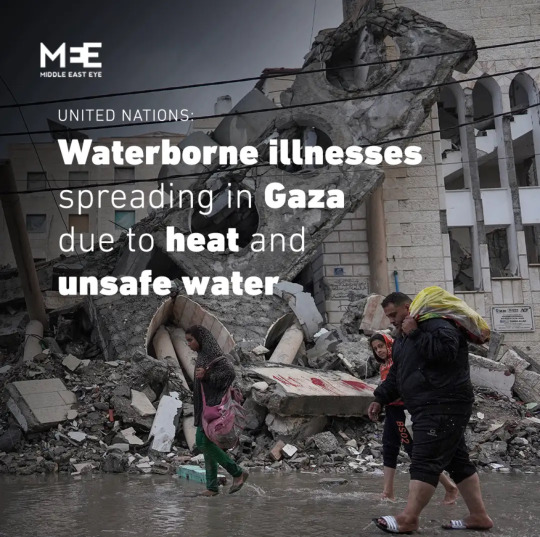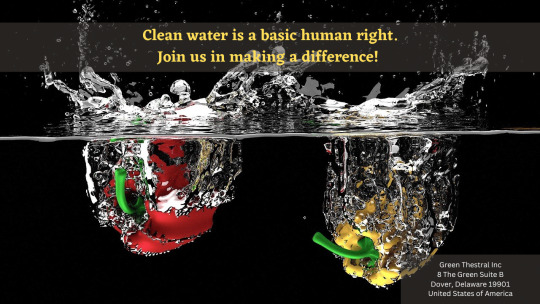#waterborne diseases
Text
Staying Healthy During the Rainy Season: Essential Precautions and measures
Discover essential health precautions and measures to stay safe during the rainy season. Learn how to protect yourself from waterborne and mosquito-borne diseases.
#rainy season health tips#monsoon health precautions#waterborne diseases#mosquito-borne diseases#JAANCH MONSOON FEVER PANEL ADVANCED
0 notes
Text
Staying Healthy During the Rainy Season: Essential Precautions
Discover essential health precautions and measures to stay safe during the rainy season. Learn how to protect yourself from waterborne and mosquito-borne diseases
#rainy season health tips#monsoon health precautions#waterborne diseases#mosquito-borne diseases#JAANCH MONSOON FEVER PANEL ADVANCED
0 notes
Link
1 note
·
View note
Text
The lack of clean water combined with rising temperatures is increasing the spread of waterborne diseases in the Gaza Strip, the UN has warned.
"It is becoming very hot there," Jamie McGoldrick, United Nations humanitarian coordinator in Gaza, told reporters via video link from Jerusalem.
"People are getting much less water than they need, and as a result, there have been waterborne diseases due to lack of safe and clean water and the disruption of the sanitation systems."
"We have to find a way in the months ahead of how we can have a better supply of water into the areas where people are currently crowded at the moment."

0 notes
Text
#lifestyle#Waterborne diseases#Treatment of Cholera#Dehydration#kauvery hospital#healthcare#healthcare blog#healthy food#healthy
0 notes
Text
বর্ষা মানেই জলবাহিত রোগের আশঙ্কা, আপনি সতর্ক তো?
Monsoon Health:বর্ষা মানেই জলবাহিত রোগের আশঙ্কা, আপনি সতর্ক তো?
Source link
View On WordPress
0 notes
Text
0 notes
Text
Water Tank Services
Tank Inspection: Regular inspections are crucial to identify any issues or damage in water tanks services . Professionals assess the tank's structural integrity, check for leaks, evaluate the condition of fittings and valves, and recommend necessary repairs or maintenance.Tank Cleaning: Water tanks accumulate sediment, debris, and microbial growth over time. Professional tank cleaning services involve the removal of sludge, disinfection, and sanitization to ensure the water remains safe and clean.
#Water tank cleaning#Tank maintenance#Tank sanitation#Sediment removal#Algae control#Bacterial growth prevention#Tank disinfection#Water quality improvement#Sludge removal#Tank inspection#Filtration system#Chlorination process#Waterborne diseases#Tank hygiene#Reservoir cleaning#Water purification#Scale buildup prevention#Tank flushing#Decontamination#Rust removal#Tank sterilization#Biofilm control#Tank renovation#Water storage maintenance#Sedimentation prevention.
1 note
·
View note
Text
What is a brain-eating amoeba and how does it affect humans?
Brain-eating amoeba is a type of free-living amoeba that can cause a rare and deadly infection called primary amoebic meningoencephalitis. It is contracted through contaminated water entering the nose. Symptoms include headache, fever, nausea, and seizures. Treatment involves early diagnosis and administration of antifungal and anti-inflammatory drugs, but the infection is often fatal. Prevention…

View On WordPress
#Amoebic infections#Brain-eating amoeba#Infectious diseases#Neurological disorders#nourisophy#PAM#Prevention#Primary amoebic meningoencephalitis#Public Health#Treatment#Waterborne diseases
0 notes
Text
Wells, Boreholes contaminated - Ogun Govt warns flooded communities
Wells, Boreholes contaminated – Ogun Govt warns flooded communities
Ogun State Government has cautioned residents of lowlands areas affected by flooding including Isheri, Warewa, Magboro, and Arepo among others not to drink from well and borehole waters in the areas to prevent cholera and other waterborne diseases.
The state Commissioner for Environment, Mr Ola Oresanya gave the caution when he visited the border towns with a view to finding an immediate…

View On WordPress
0 notes
Text
Okay, I know we joke about our Thai BL boys being fragile but like, wet season is Flu Season for a reason, y'all:
I got these articles by searching "why does rain in Thailand make you sick." Obviously it isn't just getting wet, but waterborne diseases and others that are transmittable through contact with contaminated/stagnant water tend to thrive. So to anyone seeking to make a trip or move there (me!), plan accordingly! Be safe, and follow and respect the advice of doctors and locals.
#thai bl#our poor sick victorian boys are actually just getting sick#bed friend#ingredients#love in the air#to name a few that i know fit the trope lol#thailand#rain in thailand#disease prevention#travel#health#useful links#waterborne disease
63 notes
·
View notes
Text
Bangladesh floods leave 71 dead, fears of waterborne disease rise
2 notes
·
View notes
Text
Surprising New Research Links Infant Mortality to Crashing Bat Populations. (New York Times)
Excerpt from this New York Times story:
The connections are commonsense but the conclusion is shocking.
Bats eat insects. When a fatal disease hit bats, farmers used more pesticides to protect crops. And that, according to a new study, led to an increase in infant mortality.
According to the research, published Thursday in the journal Science, farmers in affected U.S. counties increased their use of insecticides by 31 percent when bat populations declined. In those places, infant mortality rose by an estimated 8 percent.
“It’s a seminal piece,” said Carmen Messerlian, a reproductive epidemiologist at Harvard who was not involved with the research. “I actually think it’s groundbreaking.”
The new study tested various alternatives to see if something else could have driven the increase: Unemployment or drug overdoses, for example. Nothing else was found to cause it.
Dr. Messerlian, who studies how the environment affects fertility, pregnancy and child health, said a growing body of research is showing health effects from toxic chemicals in our environment, even if scientists can’t put their fingers on the causal links.
“If we were to reduce the population-level exposure today, we would save lives,” she said. “It’s as easy as that.”
The new study is the latest to find dire consequences for humans when ecosystems are thrown out of balance. Recent research by the same author, Eyal Frank, an environmental economist at the University of Chicago, found that a die-off of vultures in India had led to half a million excess human deaths as rotting livestock carcasses polluted water and spurred an increase in feral dogs, spreading waterborne diseases and rabies.
“We often pay a lot of attention to global extinctions, where species completely disappear,” Dr. Frank said. “But we start experiencing loss and damages well before that.”
5K notes
·
View notes
Text
Achieving Goal 6: Clean Water and Sanitation for a Sustainable Future

Clean water and sanitation are fundamental human rights and essential for the well-being and prosperity of communities worldwide. Access to clean water is crucial for drinking, hygiene, agriculture, and industry. Sanitation facilities ensure the proper disposal of waste and prevent the spread of diseases. Recognizing the importance of water and sanitation, the United Nations has set Goal 6 as part of its Sustainable Development Goals (SDGs). In this article, we will explore the significance of Goal 6, its targets, and the actions needed to achieve clean water and sanitation for all.
The Importance of Goal 6: Clean Water and Sanitation
Access to clean water and sanitation is not only a pressing global issue but also a matter of basic human rights. Shockingly, according to the World Health Organization (WHO) and UNICEF, a staggering 2.2 billion people worldwide lack access to safely managed drinking water, while an overwhelming 4.2 billion people do not have access to safely managed sanitation services. These numbers highlight the scale of the problem and the urgent need for action.
The consequences of inadequate water and sanitation are far-reaching and severe. One of the most significant impacts is the spread of waterborne diseases. Contaminated water sources and poor sanitation facilities create a breeding ground for diseases like cholera, typhoid, and dysentery. These illnesses disproportionately affect vulnerable populations, including children and the elderly, leading to increased morbidity and mortality rates. Lack of access to clean water and sanitation perpetuates a cycle of poverty and ill-health, as communities struggle to break free from the burden of preventable diseases.
Child mortality is also closely linked to the absence of clean water and sanitation. Unsafe drinking water and inadequate sanitation facilities contribute to the deaths of hundreds of thousands of children each year. Diarrheal diseases, in particular, claim the lives of many young children, as their weakened immune systems make them more susceptible to the harmful effects of contaminated water. Furthermore, the time spent collecting water from distant sources and the lack of proper sanitation facilities affect children's education and overall development, perpetuating a cycle of disadvantage and limited opportunities.
In addition to the human toll, inadequate access to clean water and sanitation hinders economic development. Communities that lack reliable access to clean water face numerous challenges. For instance, the burden of water collection falls primarily on women and girls, who often spend hours each day walking long distances to fetch water. This time-consuming task takes away from opportunities for education, income generation, and other productive activities, reinforcing gender inequalities and limiting economic empowerment.
Moreover, industries and businesses also suffer when water and sanitation are compromised. Lack of clean water can impede agricultural production, affecting crop yields and food security. Industries that rely on water, such as manufacturing and tourism, face operational challenges and increased costs when they must rely on alternative, often expensive, water sources. Inadequate sanitation can lead to environmental pollution, further exacerbating health risks and harming ecosystems, which are essential for the well-being of communities and biodiversity.
The gravity of the water and sanitation crisis necessitates urgent action and a comprehensive approach. Goal 6 of the Sustainable Development Goals (SDGs) recognizes the importance of clean water and sanitation for all and sets targets to address these challenges. Governments, organizations, and individuals must prioritize investment in infrastructure development, education and awareness programs, sustainable practices, and innovative solutions.
By investing in infrastructure, such as water treatment plants, pipelines, and sanitation facilities, governments can improve access to clean water and proper waste management. Concurrently, education and awareness programs can promote proper hygiene practices, behavioral change, and the sustainable use of water resources. It is crucial to empower communities with knowledge and tools to protect their water sources and ensure sustainable practices are adopted at the individual and community levels.
Sustainable agriculture practices also play a significant role in achieving clean water and sanitation goals. Implementing water-efficient irrigation techniques, promoting organic farming, and reducing the use of harmful pesticides and fertilizers can help conserve water resources and prevent pollution. By embracing technology and innovation, such as water purification systems, smart water management systems, and affordable sanitation technologies, we can bridge the gap in access to clean water and sanitation, particularly in remote and underserved areas.
Collaboration and partnerships among governments, non-governmental organizations (NGOs), businesses, and communities are crucial for progress. By joining forces, sharing expertise, and pooling resources, we can overcome financial constraints, leverage innovative solutions, and achieve more significant impact. International cooperation, aid, and support can also play a pivotal role in assisting countries with limited resources to improve their water and sanitation infrastructure and practices.
The lack of access to clean water and sanitation remains a global crisis with far-reaching consequences. The numbers are staggering, and the impacts on health, child mortality, and economic development are severe. Achieving Goal 6 of the SDGs requires concerted efforts, investment in infrastructure, education, sustainable practices, and innovative solutions. It is only through collaboration and a commitment to this fundamental human right that we can ensure a sustainable future where every individual has access to clean water and sanitation, leading to improved health, reduced poverty, and enhanced opportunities for all.
Targets for Goal 6
Goal 6 encompasses multiple targets that aim to address the water and sanitation challenges. These targets include:
Achieving universal and equitable access to safe and affordable drinking water for all.
Ensuring access to adequate and equitable sanitation and hygiene for all.
Improving water quality by reducing pollution and increasing water treatment.
Increasing water-use efficiency and ensuring sustainable water withdrawals.
Implementing integrated water resources management at all levels.
Protecting and restoring water-related ecosystems, including mountains, forests, wetlands, rivers, and lakes.
Actions to Achieve Goal 6
To achieve Goal 6 and ensure clean water and sanitation for all, various actions need to be undertaken at local, national, and global levels. Here are some key actions:
Infrastructure Development: Governments and organizations should invest in infrastructure development to improve water and sanitation systems. This includes building water treatment plants, pipelines, and sanitation facilities to ensure access to clean water and proper waste management.
Education and Awareness: Raising awareness about the importance of clean water and sanitation is crucial. Education programs can help communities understand the benefits of proper hygiene practices and promote behavior change to prevent water pollution and ensure the sustainable use of water resources.
Sustainable Agriculture: Promoting sustainable agriculture practices can reduce water pollution from pesticides and fertilizers. Implementing efficient irrigation techniques, such as drip irrigation, can also conserve water resources.
Collaboration and Partnerships: Addressing the water and sanitation challenges requires collaboration between governments, NGOs, businesses, and communities. Partnerships can bring together expertise, resources, and innovative solutions to overcome the barriers to clean water and sanitation.
Technology and Innovation: Embracing technological advancements can greatly contribute to achieving Goal 6. Innovative solutions, such as water purification systems, smart water management systems, and affordable sanitation technologies, can improve access to clean water and sanitation in remote areas.
Water Conservation: Encouraging water conservation practices at the individual and community levels is essential. Simple measures like fixing leaks, using water-efficient appliances, and harvesting rainwater can go a long way in reducing water wastage and ensuring the availability of clean water.
Success Stories and Best Practices
Several success stories demonstrate that progress can be made in achieving Goal 6. For instance, in Rwanda, the government's commitment to improving water and sanitation services has resulted in significant improvements in access to clean water, particularly in rural areas. The introduction of community-led total sanitation programs in Bangladesh has successfully improved sanitation practices and reduced open defecation.
Challenges and the Way Forward
Despite the progress made, significant challenges remain in achieving Goal 6. Limited financial resources, inadequate infrastructure, climate change impacts, and conflicts are some of the obstacles that need to be overcome. However, there are opportunities to address these challenges. By increasing investments in water and sanitation, promoting sustainable practices, and strengthening partnerships, we can create a future where clean water and sanitation are accessible to all.
Conclusion
Goal 6: Clean Water and Sanitation is a critical component of the Sustainable Development Goals, highlighting the significance of access to clean water and sanitation for all. Achieving this goal requires concerted efforts from governments, organizations, communities, and individuals. By implementing the targets and taking necessary actions, we can ensure a sustainable future with clean water and sanitation, improving health, reducing poverty, and fostering economic development worldwide. Let us work together to make Goal 6 a reality and create a world where no one is deprived of this basic human right.
#Importance of clean water and sanitation#Achieving Goal 6: Clean Water and Sanitation#Access to clean water and sanitation#Waterborne diseases and sanitation#Goal 6 and global water crisis#Sustainable Development Goal 6: Clean Water and Sanitation#Lack of access to clean water and sanitation#Water and sanitation challenges worldwide#Promoting clean water and sanitation for all#Impact of inadequate water and sanitation#Clean water and sanitation for a sustainable future#Achieving universal access to clean water#Improving sanitation facilities worldwide#Water quality and pollution reduction#Sustainable water management practices#Protecting water-related ecosystems#Infrastructure development for clean water#Education and awareness for water and sanitation#Innovative solutions for clean water access#Addressing water scarcity and sanitation issues#Achieving equitable access to clean water#Ensuring sustainable sanitation services#Water conservation for a better future#Economic benefits of clean water and sanitation#Overcoming water and sanitation challenges#Success stories in achieving Goal 6#Partnership for clean water and sanitation#Technology advancements in water management#Achieving clean water and sanitation in rural areas#Breaking the cycle of poverty through water and sanitation
0 notes
Text
so can you drink straight from the cola river or is it full of calorum disease do you have to boil it first?
#Calorum#I have. Questions about every single fucking things edibility#I know you can starve in the wilds in calorum but how easy is it. Are there parasites in calorum? Are there waterborne diseases?#Are all the oceans salty? Does salinity matter for calorans? Are the oceans drinkable or not
0 notes
Text
“Adré, Chad, October 19, 2023—Since fighting erupted in Sudan in April, about 430,000 refugees have fled to Chad, and more are expected to arrive in the coming months. Health conditions are precarious for the approximately 200,000 refugees now staying in camps in Adré, eastern Chad, due to a lack of water, food, shelter, and sanitation facilities.
Doctors Without Borders/Médecins Sans Frontières (MSF) teams are providing medical care in Adré and responding to critical water needs, but ongoing water scarcity may have disastrous consequences if other organizations do not similarly respond.
"In the refugee camps at Adré, some 200,000 people are receiving just five to six liters of water daily, well below the recommended emergency standard of 20 liters per day," said Christophe Chauliac, MSF project coordinator in Adré. "MSF serves as the primary water provider in the camps, distributing around 600,000 liters daily and covering more than 80 percent of the available water supply for refugees. Despite these efforts, this amount is insufficient, especially in scorching weather. An insufficient water supply hinders basic needs such as washing and cooking, forcing people to turn to unsafe sources and increasing the risk of waterborne diseases such as diarrhea and cholera."
3K notes
·
View notes